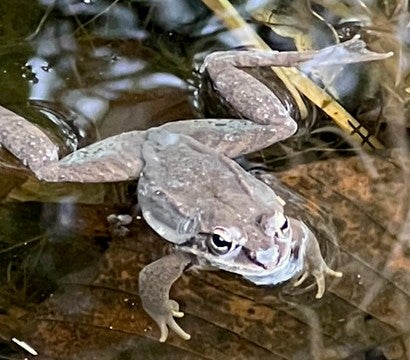By some human standards, my pond is a hot mess. Underneath and around the water lilies are fallen leaves, branches and other debris of decomposing plants. Along the edges, sea oats, sedges and swamp sunflowers hug the rocks.
But if humans are picky in their desire for orderliness, frogs are just as picky in their need for the opposite. By amphibian standards, the watering hole my husband and I carved out of our remaining lawn is an oasis: A still-water pond filled with decay brims with life. Ours is only 10 feet in diameter, but what it lacks in size it makes up for in rich habitat.
In the wild, some natural ponds “smell not the greatest,” says Cy Mott, an associate professor of biology at Eastern Kentucky University. “Amphibians not only don’t care about that, they can sometimes determine where a pond is and how high-quality it is by the smell. When I go wading into some of my [study] ponds, it’s straight-up methane because you’re releasing the products of decomposition. But it’s great for amphibians.”

Animals keep the balance too
Fish-free, still-water ponds have an undeserved reputation for attracting mosquitoes. But fish aren’t the only mosquito predators. “There are no extra mosquitoes in our yard,” says Berrie. “The frogs are eating them all, and the dragonflies are eating them all.”
Mosquitoes breed in stagnant water, but natural ponds are in constant motion. Water striders, predaceous diving beetles and frogs consume mosquito larvae. Dragonflies, some of whom can eat hundreds of mosquitoes daily, zip over the surface. Hummingbirds nab adult mosquitoes and feed them to their young.
At a time of rising temperatures and shrinking wetlands, our pond is also a lifesaver for butterflies, mud dauber wasps, cardinals and sparrows, who all sip at the edges. Rabbits, foxes, deer, chipmunks and raccoons swing by for nighttime libations. Unfortunately, many homeowners use harmful products like netting to exclude some of these animals. But a humane pond is a 24-hour tavern that doesn’t discriminate, welcoming all comers to its “messy,” vibrant shores—and bringing far more beauty and life than a sterile, chemical-laden pond ever could.
Want more content like this?
This was written and produced by the team behind All Animals, our award-winning magazine. Each issue is packed with inspiring stories about how we are changing the world for animals together.
Learn MoreSubscribe



